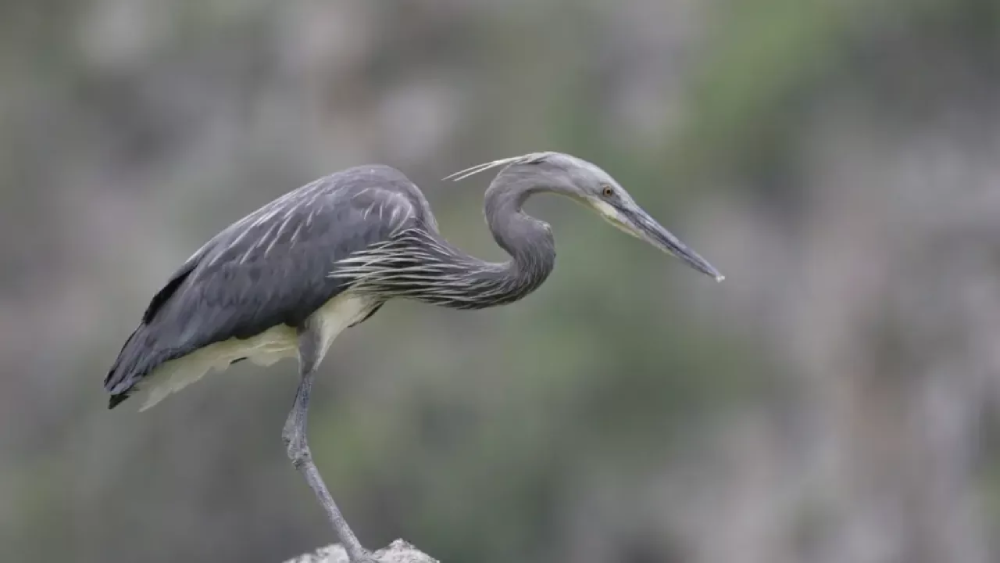The White-bellied Heron (*Ardea insignis*), also known as the Imperial Heron, is one of the rarest and most elusive bird species in the world. This magnificent bird, with its striking appearance and significant ecological role, faces critical threats that endanger its very existence. Understanding the White-bellied Heron’s habitat, behavior, and conservation status is essential for developing effective strategies to ensure its survival.
Description and Identification
The White-bellied Heron is a large wading bird, standing about 127 cm (50 inches) tall, making it one of the largest heron species. It features a predominantly dark grey body with a distinctive white underbelly, which gives it its name. The species has a long neck and legs, a robust bill, and broad wings, which are adapted for its wading lifestyle. During flight, its slow wing beats and large size make it easily recognizable.

Habitat and Distribution
Historically, the White-bellied Heron was found across a broad range in the foothills of the Himalayas, spanning from northeast India through Bhutan and Myanmar to the hills of southwest China. Today, its range has significantly contracted, and the species is primarily found in Bhutan, with smaller populations in India and Myanmar. The heron prefers pristine riverine habitats, which are characterized by wide, slow-flowing rivers with sandy or gravelly banks. These environments provide ample feeding opportunities and are crucial for the bird’s breeding and foraging activities. The species is also found in subtropical or tropical forests that are in close proximity to these riverine systems.
Behavior and Ecology
The White-bellied Heron is a solitary and highly territorial bird. It is known for its elusive nature, often shying away from human presence. This behavior, combined with its preference for remote habitats, makes it challenging to study. Feeding primarily on fish, amphibians, and large insects, the heron uses a “stand-and-wait” hunting technique, remaining motionless for extended periods before striking with its sharp bill. This method is highly effective in its riverine habitat where prey is abundant.
Breeding season for the White-bellied Heron typically occurs from February to May. Nesting usually takes place in tall trees near water bodies, where the female lays 2-4 eggs. Both parents share responsibilities in incubating the eggs and feeding the chicks.
Conservation Status and Threats
The White-bellied Heron is listed as Critically Endangered on the IUCN Red List. Current estimates suggest that fewer than 250 mature individuals remain in the wild. Habitat destruction, particularly deforestation, agricultural expansion, and infrastructure development, including dam construction, have led to significant loss and degradation of the heron’s habitat. Moreover, increased human activity along riverine habitats, including fishing, boating, and tourism, disrupts the heron’s breeding and feeding grounds. Water pollution from agricultural runoff and industrial activities contaminates the heron’s habitat, impacting both its health and food sources. Changes in climate patterns are altering river flows and habitats, further stressing the already fragile ecosystems that support the White-bellied Heron.
Conservation Efforts
Efforts to conserve the White-bellied Heron are multifaceted, involving habitat protection, research, and also community engagement. Establishing and effectively managing protected areas that encompass critical habitats is crucial. In Bhutan, several protected areas and biological corridors have been designated to safeguard the heron’s environment. Ongoing research and monitoring programs help track population trends, understand ecological needs, and identify emerging threats. Organizations like the Royal Society for Protection of Nature (RSPN) in Bhutan play a pivotal role in these efforts. Engaging local communities in conservation efforts ensures sustainable coexistence. Educational programs raise awareness about the heron’s importance and the need to protect its habitat. Cross-border cooperation between countries within the heron’s range is essential for its conservation. Sharing data, resources, and best practices enhances the effectiveness of conservation strategies.
Conclusion
The is a symbol of the rich biodiversity found in the Himalayan region and a reminder of the delicate balance within our ecosystems. Despite facing severe threats, the dedication of conservationists and also local communities provides hope for its future. Protecting the White-bellied Heron requires a concerted effort to preserve its habitat, mitigate threats, and promote sustainable practices. By doing so, we not only save a species from extinction but also uphold the ecological integrity of some of the world’s most pristine natural environments.









